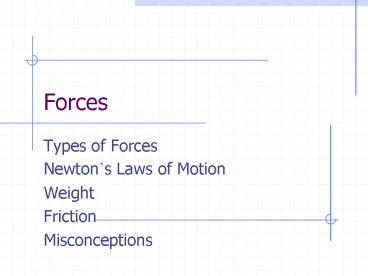Forces PowerPoint PPT Presentation
1 / 22
Title: Forces
1
Forces
- Types of Forces
- Newtons Laws of Motion
- Weight
- Friction
- Misconceptions
2
Forces
- A force is a push or a pull.
- weight
- pulling a wagon
- friction
- Objects do not always have to be in contact with
each other. - The sun exerts a force on the Earth.
3
Four Fundamental Forces
- Gravity
- Anything that has mass has a gravitational
attraction. The larger the mass, the more
gravity. - It is the weakest of the four.
- Electromagnetic
- Force caused by charged particles.
- Attractive or Repulsive
4
Four Fundamental Forces cont
- Strong
- Nuclear (inside the nucleus) holds the nucleus
together. - Strongest of the four.
- Only acts over a small distance.
- Weak
- Nuclear
- Form of EM force.
- Responsible for radioactive decay.
5
Newtons Laws of Motion
6
Newtons First Law
- Three parts
- An object in motion stays in motion.
- An object at rest stays at rest.
- Unless acted on by an outside force.
- Inertia- property of matter based on mass says
the same thing as Newtons 1st Law
7
Newtons 1st Law Example
- Reason for Seatbelts.
- In a front-end-collision, a unrestrained person
will continue to go forward until something stops
him/her. Maybe the windshield. - You can pull a table cloth out from underneath
dishes an they stay.
8
A Word about Inertia
- Inertia is a property of matter that is
independent of gravity. - i.e If someone throws a can of soup at you in
space, it would still hurt if it hit you in the
head. - Likewise, after you get hit you kick the wall of
the shuttle and it still hurts.
9
Newtons Third Law
- For every action there is an equal and opposite
reaction. - example A book resting on a desk exerts a force
down equal to the force exerted up on the book.
10
Newtons 3rd Law Example
- A bullet applies the same force on a gun as the
gun applies to the bullet. - The Earth applies the same force on a person as
the person applies to the Earth.
11
Newtons 3rd Law Example
- A baseball bat applies the same force to a
baseball as the baseball applies to the bat. - So why do they respond differently?
- Mass.
- We will use Newtons 2nd law to explain why.
12
Newtons Second Law
- The acceleration of an object is directly
proportional to the net Force and inversely
proportional to the mass of the object. - a F / m
- F ma
- Net force sum of all the forces acting on the
object
13
Units
- Look at the units for force.
- F ma kg m/s2
- This is way too much to write so lets give Newton
some credit. - Force is measured in Newtons (N).
14
Using Newtons 2nd Law
- Back to the baseball and bat question. If the
forces acting on each other are the same, why
does each respond differently. - A smaller mass means a higher acceleration. A
larger mass means a lower acceleration.
15
Using Newtons 2nd Law
- Fbat Fbaseball
- Ma mA
16
Weight is a Special Force.
- Weight and mass are different!!!
- Start with F ma
- Gravity accelerates objects at a rate of 9.8
m/s2. - Call the force weight.
- Wmg
17
Friction
- Friction is a force that oppose motion.
- Friction is due to the electromagnetic attraction
between the two surfaces. - Is friction a good thing?
- Could be. You need it to walk and not fall on the
ice. - Much of the time its turned into heat that is not
needed. (waste)
18
Two types of Friction
- Static friction the frictional force that
prevents an object from starting to move - Kinetic friction the frictional force of a
moving object - Kinetic friction is less than static friction.
- This is the idea behind anti-lock breaks.
19
Frictional Strength
- What determines the strength of the friction?
- how hard the two surfaces are pushing on each
other (N, normal force) - the type of materials (m coefficient of
friction) - Items that have no effect
- speed of the object
- contact area
20
Coefficient of Friction
- Determined by the type of material
- Steel on ice has a low m
- Rubber on asphalt has a high m
- Ff m FN
21
Some Misconceptions
- An object that is moving must have a net force
exerted on it. - Nope. An object could be moving and not
accelerating. - If the velocity is zero then the acceleration and
force must be zero. - Nope. Consider a ball at the top of its path.
- An object must move in the direction of the net
force. - Nope. An object must accelerate in the direction
of the net force.
22
Some More Misconceptions
- Heavier objects fall faster than light objects.
- All objects accelerate at 9.8 m/s2 (neglecting
air resistance) - When two objects collide, the bigger object
always applies a larger force. - Nope. Think Newtons Third Law
- If an object accelerates it must be changing its
speed. - Nope. It could be changing directions.

